Executive summary
The apprentice panel survey was designed by the Institute for apprenticeships and technical education (the Institute)'s apprentice panel. It aimed to gain insight into apprentices' views of apprenticeship standards. This publication sets out the key findings from this survey.
The methodology for running this survey should be considered when interpreting these findings before drawing any conclusions (see methodological considerations section).
The key findings from this are:
- 85% of respondents had signed a commitment statement.
- 62% of respondents reported receiving at least 20% off-the-job training.
- 70% of respondents were satisfied that their off-the-job training was useful in their job.
- 87% of respondents would recommend their apprenticeship to others who wish to train in that occupation.
Methodological considerations
This survey was produced by the Institute's apprentice panel members to gather data on apprentices’ experiences of their apprenticeships. The survey was open to anyone but was specified as being for those who were on an apprenticeship standard. It was advertised by the apprentice panel on social media and contacts as well as through their employers. The survey was open from 30 April 2020 until 12 June 2020. There were 1,049 complete, submitted responses.
The sample was self-selected. Participants had to actively seek out and take part in the survey rather than being randomly selected and approached. These results are therefore not representative of all apprentices. There will be non-response bias in the findings. Those that did not participate are likely to have differing views than those who did respond. We do not know the extent to which opinions may vary. However, it is reasonable to conclude that those who do not know that they are on an apprenticeship, which may be because they have not signed a commitment statement, or do not receive any training, or both, are unlikely to have self-selected to have taken part in this survey.
The results here are therefore more favourable in terms of levels of training and satisfaction. The latest apprenticeship evaluation learner survey, which has a more robust sampling process, found that just 30% were getting the minimum requirements of formal training. Note, formal training has a slight definition difference to off-the-job training but it is considered a close proxy. It is not clear if it is an under or overestimation of off-the-job training. Further detail on this can be found in the apprenticeship evaluation survey technical report.
Further to this, the weighting has not been applied to counteract over/underrepresentation of certain demographics in this survey compared to the population of apprentices. The sample is therefore not representative based on the characteristics of the apprenticeship programme.
We have assessed the differences between the sample and the wider starts population for route, level or employer size which can be seen below. We have compared responses to the survey with starts on apprenticeship standards in 2018/19, for route, region and level.
For employer size, we were only able to compare to starts on frameworks and standards combined. A better comparison would be to compare to participation in the programme rather than starts, however, this data was not publicly available.
We did not collect data on other characteristics which may too have an impact on the apprenticeship experience. These could include but are not limited to age, prior employment with the same employer or prior knowledge of the occupation.
Route
The proportion of survey responses by route does not match the proportion of apprenticeship starts by route in the last academic year (2018/19). There is a much higher relative response rate from within the engineering and manufacturing route and a lower response rate from within the care services route. This may be due to the impact of COVID-19 as the survey was run during the pandemic, as discussed further below.
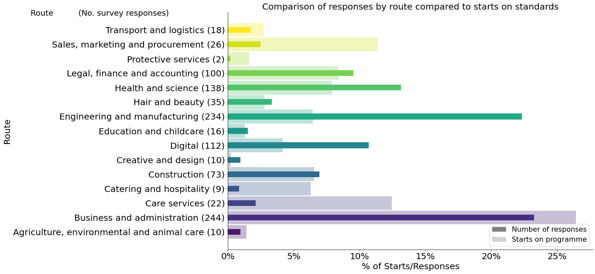
Source: starts on standards in the academic year 2018/19 from Department for Education statistics and responses from the survey
Level
The proportion of survey responses by level does not match the proportion of apprenticeship starts by level in the 2018/19 academic year. Level 6 is significantly over-represented and level 2 is under-represented.
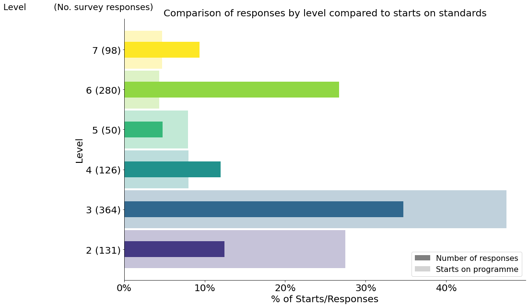
Source: starts on standards in the academic year 2018/19 from Department for Education statistics and responses from the survey
Employer size
The majority of respondents are on apprenticeships with large employers. This represents a response bias in favour of apprentices employed by large employers. It should be noted, however, that this comparison uses data for frameworks and standards rather than just standards. This because we must use the individualised learner record (ILR) dataset matched to the Inter-departmental business register (IDBR) to obtain the employer size. This is only available at an aggregate level.
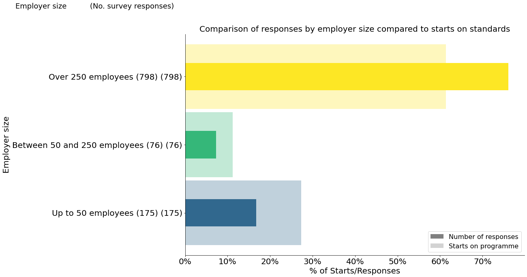
Source: Apprenticeships in England by industry characteristics - starts on standards and frameworks in 2018/19 excluding a small number that reported the employer size as 'unknown' which have been matched to the IDBR; and responses from the survey
Region
The South East and West Midlands had higher responses proportionally compared to starts in 2018/19. Additionally, Yorkshire and the Humber, the East of England and London were under-represented.
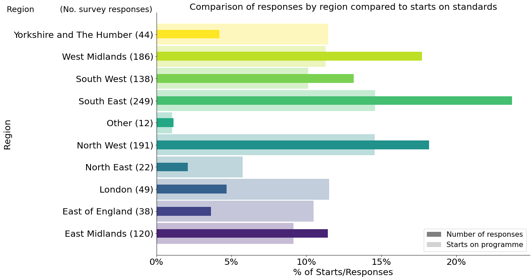
Source: starts on standards in the academic year 2018/19 from Department for Education statistics and responses from the survey
As this survey collected data when the COVID-19 pandemic was occurring, this may have impacted apprentices’ experiences. Additionally, COVID-19 is likely to have impacted the survey response demographics.
Findings
The following section provides a summary of responses, grouped into themes of questions.
Commitment satisfaction
Respondents were asked questions around the documents that they should have seen, read or signed. This found:
- 59% had seen or read their occupational standard
- 55% had seen or read their assessment plan
- 85% had signed a commitment statement
- 24% had visited the Institute website
Training
In the survey, respondents were asked if they received off-the-job training.
This found:
- 62% said they get at least 20% off-the-job training.
- 32% said they get less than 20% off-the-job training.
- 6% said they get no training.
These findings are more favourable compared to the latest apprenticeship evaluation survey. This could in part be due to when the survey was carried out as there is a lag in reporting on the apprenticeship evaluation survey. However, the self-selected sampling approach used in this survey is likely to explain much of the difference because those receiving little or no training may not know they are on an apprenticeship and are therefore unlikely to take part in this survey and therefore these results may present a biased view.
Further to this, the questions around training are asked very differently in this survey compared to the evaluation survey. Respondents were simply asked:
‘Do you receive off-the-job training’, with the following options:
- No
- Less than 20% off-the-job training
- More than 20% off-the-job training
The evaluation survey calculates the proportion of hours in training and worked hours. The training hours are based on the number of hours training at an external provider and training at the workplace away from their regular work activities.
The apprentice panel survey then asked about satisfaction with training. Around two-thirds of respondents were generally satisfied when asked about their training content and training plans as seen in the figure below. The questions asked were:
- Q_1: How satisfied are you with the time you are given to complete off-the-job training? (62% satisfied/very satisfied).
- Q_2: How satisfied are you that your training provider was able to create a training plan that reflects the requirements of the apprenticeship standard training plan? (61% satisfied/very satisfied).
- Q_3: How satisfied are you that your training provider was able to create a training plan that reflects your individual learning needs? (57% satisfied/very satisfied).
- Q_4: How satisfied are you that the work you had to do to complete apprenticeship e.g. written assignments was relevant to the occupation and standard apprenticeship work? (66% satisfied/very satisfied).
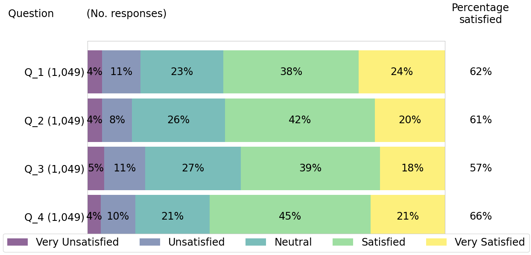
Respondents were also asked:
How satisfied are you that your training is delivered via high quality including training delivered by both your employer and any training provider?
Satisfaction levels varied depending on the topic. Preparation for end-point-assessment had low proportions satisfied (32%) or very satisfied (11%) whereas when considering feedback on assignments progress, 40% were satisfied and a further 23% were very satisfied. When considering teaching workshops 46% responded as satisfied and 24% as very satisfied.

Learning
Respondents were asked if they were finding that their training was useful in their job. This was split by on and off-the-job training. As can be seen in the figure below, a higher proportion (40%) responded saying that they were very satisfied with the on-the-job training compared to just 25% reporting very satisfied with off-the-job training.
It is important to note, however, that respondents were not given full descriptions of what is considered ‘on-the-job’ and ‘off-the-job’ training at the time of questioning. This may have led them to draw their own conclusions. For example, they may have drawn the distinction as ‘training at the provider’ vs. ‘training at the workplace’ which is not correct.

Relevance
Respondents were asked questions about how relevant their apprenticeship has been in terms of learning the right skills and setting them up for their career. At least 80% of respondents were either very satisfied or satisfied with each of the following questions:
- Q_1: How satisfied are you that your apprenticeship has laid/will lay the foundation for a successful future career? (82% satisfied/very satisfied).
- Q_2: Upon completion of your apprenticeship do you have confidence that you will be qualified to do your job? (84% satisfied/very satisfied).
- Q_3: As far as you can tell how satisfied are you that in your apprenticeship you have learned/are learning up-to-date skills knowledge and behaviours? (82% satisfied/very satisfied).
- Q_4: As far as you can tell how satisfied are you that in your apprenticeship you have learned/are learning skills knowledge and behaviours that will be needed for you to adapt to future developments in your industry? (81% satisfied/very satisfied).

Duration
Almost two-thirds of respondents (62%) stated that the duration feels about the right amount of time to be ready to take the end-point assessment (EPA). Similarly, 63% stated that this duration reflected the amount of learning to be fully occupationally competent. For both questions, around 10% did not feel it was long enough and the remaining responded that it was ‘more than enough time to do the learning required’.
Employment
Three-quarters (75%) of respondents stated that they were either 'satisfied' or 'very satisfied' that they are able to gain access at work to all the experience necessary to complete their apprenticeship training. A further 16% were neutral and 8% unsatisfied or very unsatisfied.
Respondents were also asked if their employer is taking steps to help them cope with apprenticeship pressures and 66% were satisfied or very satisfied this was happening. A further 22% were neutral and 12% were unsatisfied or very unsatisfied.
End-point assessment
Of all respondents, 38% did not know who their end-point assessment organisation (EPAO) is. However, 93% of respondents reported they either definitely or are likely to take their EPA. Apprentices nearing gateway should be aware of who their EPAO is and the EPAO is expected to engage with the apprentice to prepare them for EPA. Within this survey, however, it is not possible to identify where in an apprenticeship the respondents are.
Recommend apprenticeships
The majority (87%) of respondents said that they would recommend their apprenticeship to other people wanting to train in their occupation.
COVID-19 impact
When asked if the COVID-19 outbreak was having significant impacts on their apprenticeship, over half (58%) of respondents reported that it had. As noted in the methodological section, caution should be used when interpreting these findings as we do not fully understand the impacts of any sampling bias.

